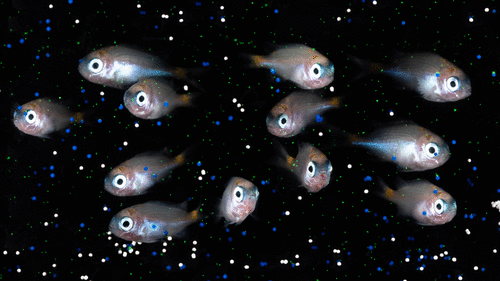当前位置:
X-MOL 学术
›
Environ. Sci. Technol.
›
论文详情
Our official English website, www.x-mol.net, welcomes your feedback! (Note: you will need to create a separate account there.)
Effects of Virgin Micro- and Nanoplastics on Fish: Trends, Meta-Analysis, and Perspectives.
Environmental Science & Technology ( IF 11.4 ) Pub Date : 2020-04-01 , DOI: 10.1021/acs.est.9b05995 Hugo Jacob 1, 2 , Marc Besson 1 , Peter W Swarzenski 1 , David Lecchini 2, 3 , Marc Metian 1
Environmental Science & Technology ( IF 11.4 ) Pub Date : 2020-04-01 , DOI: 10.1021/acs.est.9b05995 Hugo Jacob 1, 2 , Marc Besson 1 , Peter W Swarzenski 1 , David Lecchini 2, 3 , Marc Metian 1
Affiliation

|
Environmental plastic pollution is a major ecological and societal concern today. Over the past decade, a broad range of laboratory and experimental studies have complemented field observations in the hope of achieving a better understanding of the fate and impact of micro- and/or nanoplastics (MP/NP) on diverse organisms (e.g., birds, fish, and mammals). However, plastic pollution remains challenging to monitor in the environment and to control under laboratory conditions, and plastic particles are often naturally or experimentally co-contaminated with diverse chemical pollutants. Therefore, our understanding of the effects of virgin MP/NP in freshwater and marine fish is still limited. Here, we performed a systematic review of the most up-to-date literature on the effects of virgin MP/NP on fish under laboratory conditions. A total of 782 biological endpoints investigated in 46 studies were extracted. Among these endpoints, 32% were significantly affected by exposure to virgin MP/NP. More effects were observed for smaller plastic particles (i.e., size ≤20 μm), affecting fish behavioral and neurological functions, intestinal permeability, metabolism, and intestinal microbiome diversity. In addition, we propose suggestions for new research directions to lead toward innovative, robust, and scientifically sound experiments in this field. This review of experimental studies reveals that the toxicity of virgin MP/NP on fish should be more systematically evaluated using rigorous laboratory-based methods and aims toward a better understanding of the underlying mechanisms of this toxicity to fish.
中文翻译:

原始的微量和纳米塑料对鱼类的影响:趋势,荟萃分析和观点。
如今,环境塑料污染是生态和社会关注的主要问题。在过去的十年中,广泛的实验室和实验研究对现场观察进行了补充,以期更好地了解微塑料和/或纳米塑料(MP / NP)对多种生物(例如鸟类,鱼和哺乳动物)。但是,塑料污染仍然难以在环境中进行监测并在实验室条件下进行控制,而且塑料颗粒通常会自然地或通过实验与各种化学污染物共同污染。因此,我们对纯净MP / NP在淡水和海水鱼类中的作用的了解仍然有限。在这里,我们对原始MP / NP在实验室条件下对鱼类的影响进行了最新文献的系统综述。提取了在46项研究中调查的782个生物学终点。在这些终点中,有32%受到未加工MP / NP的显着影响。对于较小的塑料颗粒(即,尺寸≤20μm),观察到了更大的影响,影响了鱼类的行为和神经功能,肠道通透性,代谢和肠道微生物组多样性。此外,我们提出了一些新的研究方向的建议,以引领该领域的创新,健壮和科学合理的实验。这项对实验研究的回顾表明,应使用严格的实验室方法对原始MP / NP对鱼类的毒性进行更系统的评估,其目的是更好地了解这种毒性对鱼类的潜在机制。32%的人受到纯净MP / NP暴露的严重影响。对于较小的塑料颗粒(即,尺寸≤20μm),观察到了更大的影响,影响了鱼类的行为和神经功能,肠道通透性,代谢和肠道微生物组多样性。此外,我们提出了一些新的研究方向的建议,以引领该领域的创新,健壮和科学合理的实验。这项对实验研究的回顾表明,应使用严格的实验室方法对原始MP / NP对鱼类的毒性进行更系统的评估,其目的是更好地了解这种毒性对鱼类的潜在机制。32%的人受到纯净MP / NP暴露的严重影响。对于较小的塑料颗粒(即,尺寸≤20μm),观察到了更大的影响,影响了鱼类的行为和神经功能,肠道通透性,代谢和肠道微生物组多样性。此外,我们提出了一些新的研究方向的建议,以引领该领域的创新,健壮和科学合理的实验。这项对实验研究的回顾表明,应使用严格的实验室方法对原始MP / NP对鱼类的毒性进行更系统的评估,其目的是更好地了解这种毒性对鱼类的潜在机制。影响鱼类的行为和神经功能,肠道通透性,代谢和肠道微生物组多样性。此外,我们提出了一些新的研究方向的建议,以引领该领域的创新,健壮和科学合理的实验。这项对实验研究的回顾表明,应使用严格的实验室方法对原始MP / NP对鱼类的毒性进行更系统的评估,其目的是更好地了解这种毒性对鱼类的潜在机制。影响鱼类的行为和神经功能,肠道通透性,代谢和肠道微生物组多样性。此外,我们提出了一些新的研究方向的建议,以引领该领域的创新,健壮和科学合理的实验。这项对实验研究的回顾表明,应使用严格的实验室方法对原始MP / NP对鱼类的毒性进行更系统的评估,其目的是更好地了解这种毒性对鱼类的潜在机制。
更新日期:2020-04-23
中文翻译:

原始的微量和纳米塑料对鱼类的影响:趋势,荟萃分析和观点。
如今,环境塑料污染是生态和社会关注的主要问题。在过去的十年中,广泛的实验室和实验研究对现场观察进行了补充,以期更好地了解微塑料和/或纳米塑料(MP / NP)对多种生物(例如鸟类,鱼和哺乳动物)。但是,塑料污染仍然难以在环境中进行监测并在实验室条件下进行控制,而且塑料颗粒通常会自然地或通过实验与各种化学污染物共同污染。因此,我们对纯净MP / NP在淡水和海水鱼类中的作用的了解仍然有限。在这里,我们对原始MP / NP在实验室条件下对鱼类的影响进行了最新文献的系统综述。提取了在46项研究中调查的782个生物学终点。在这些终点中,有32%受到未加工MP / NP的显着影响。对于较小的塑料颗粒(即,尺寸≤20μm),观察到了更大的影响,影响了鱼类的行为和神经功能,肠道通透性,代谢和肠道微生物组多样性。此外,我们提出了一些新的研究方向的建议,以引领该领域的创新,健壮和科学合理的实验。这项对实验研究的回顾表明,应使用严格的实验室方法对原始MP / NP对鱼类的毒性进行更系统的评估,其目的是更好地了解这种毒性对鱼类的潜在机制。32%的人受到纯净MP / NP暴露的严重影响。对于较小的塑料颗粒(即,尺寸≤20μm),观察到了更大的影响,影响了鱼类的行为和神经功能,肠道通透性,代谢和肠道微生物组多样性。此外,我们提出了一些新的研究方向的建议,以引领该领域的创新,健壮和科学合理的实验。这项对实验研究的回顾表明,应使用严格的实验室方法对原始MP / NP对鱼类的毒性进行更系统的评估,其目的是更好地了解这种毒性对鱼类的潜在机制。32%的人受到纯净MP / NP暴露的严重影响。对于较小的塑料颗粒(即,尺寸≤20μm),观察到了更大的影响,影响了鱼类的行为和神经功能,肠道通透性,代谢和肠道微生物组多样性。此外,我们提出了一些新的研究方向的建议,以引领该领域的创新,健壮和科学合理的实验。这项对实验研究的回顾表明,应使用严格的实验室方法对原始MP / NP对鱼类的毒性进行更系统的评估,其目的是更好地了解这种毒性对鱼类的潜在机制。影响鱼类的行为和神经功能,肠道通透性,代谢和肠道微生物组多样性。此外,我们提出了一些新的研究方向的建议,以引领该领域的创新,健壮和科学合理的实验。这项对实验研究的回顾表明,应使用严格的实验室方法对原始MP / NP对鱼类的毒性进行更系统的评估,其目的是更好地了解这种毒性对鱼类的潜在机制。影响鱼类的行为和神经功能,肠道通透性,代谢和肠道微生物组多样性。此外,我们提出了一些新的研究方向的建议,以引领该领域的创新,健壮和科学合理的实验。这项对实验研究的回顾表明,应使用严格的实验室方法对原始MP / NP对鱼类的毒性进行更系统的评估,其目的是更好地了解这种毒性对鱼类的潜在机制。



























 京公网安备 11010802027423号
京公网安备 11010802027423号